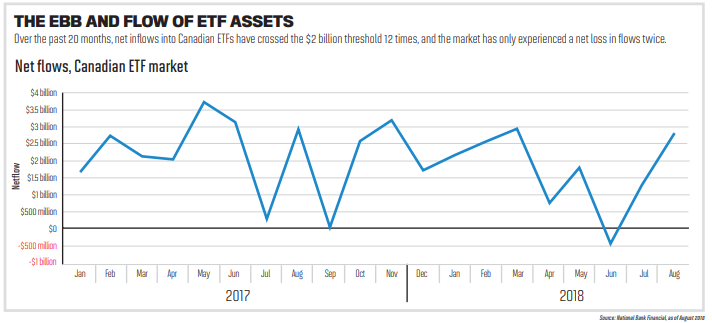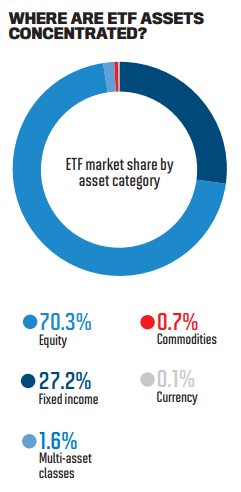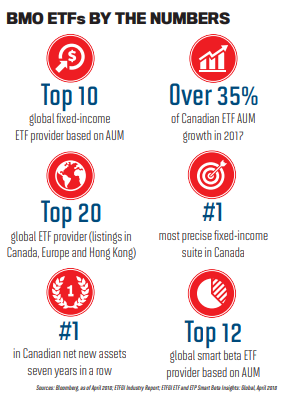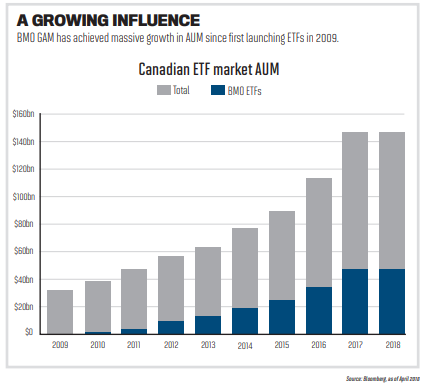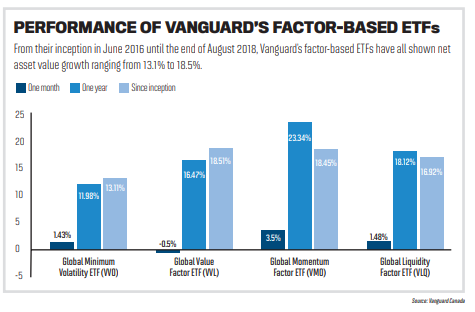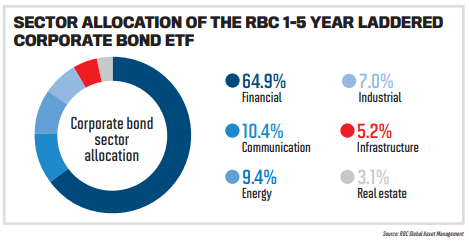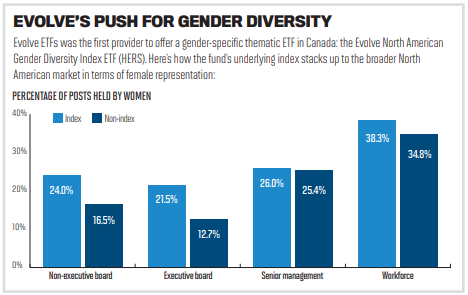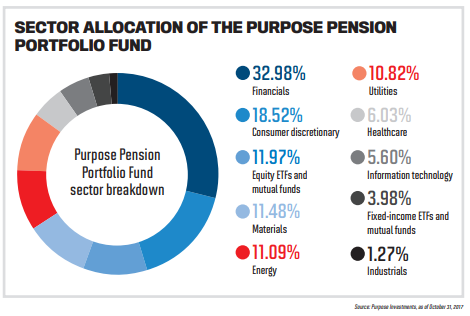ETFs continue to gain popularity with investors. Wealth Professional Canada talked to some of the country’s biggest ETF trend leaders to get their view on the current state of the ETF landscape

Exchange-traded funds have a long history in Canada, but the investment vehicle has gained considerable traction in the last few years. More and more providers are popping up; as of July 31, there were 621 ETFs in Canada, amounting to almost $164 billion in assets, according to the Canadian ETF Association. The surge in popularity was most noticeable between 2015 and 2017, when ETF assets rose from $89.5 billion to $147.1 billion.
With more ETF providers crowding the market, the need for innovation has never been higher. Today’s ETFs encompass everything from fixed income to equities, active to passive solutions, and even factor-based and thematic options. The abundance of choice in the market, combined with new trends such as the race to 0% management fees, can make finding the right ETFs for an investor quite a challenge. With that in mind, Wealth Professional Canada spoke to some of the leading ETF providers to find out which corners of the ETF market advisors should be paying attention to.
Inside the BMO ETFs team
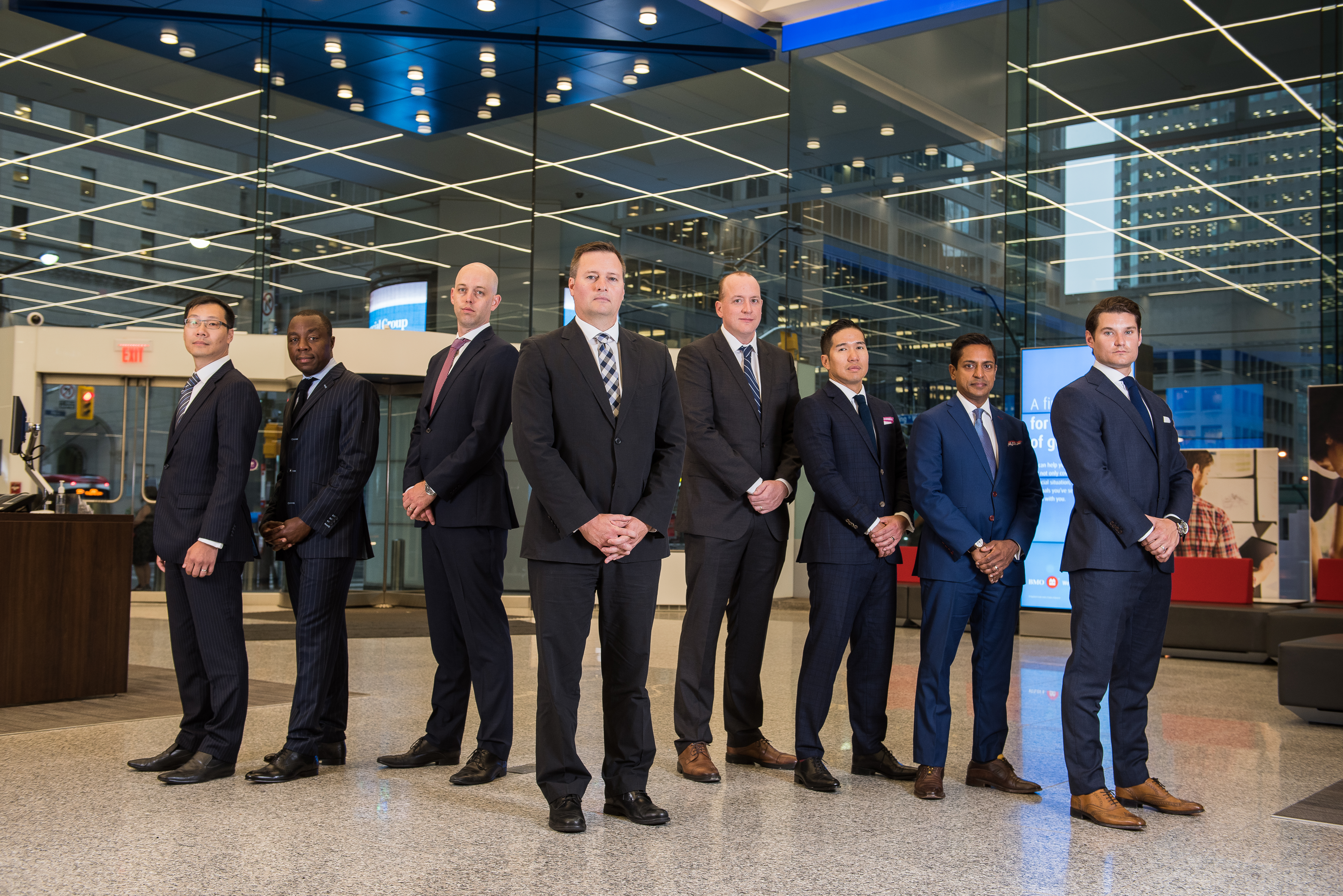
When BMO Global Asset Management launched its ETFs business in 2009, it was literally starting from nothing – zero assets under management. Although the firm was backed by the name of a renowned Canadian banking institution, in reality, it faced the same obstacles as any startup fund provider.
Nine years later, the growth of BMO ETFs has been nothing short of astronomical. From surpassing $7 billion in AUM in three years to launching some of the most innovative ETFs in the world, it’s been a high-octane journey of smashing targets and continuous improvement. Here, WPC talks to some of the BMO ETFs team’s main players to get the inside scoop on their success so far.
KEVIN GOPAUL
Head, BMO Global Asset Management Canada
ROB BECHARD
Managing director, head of ETF portfolio management
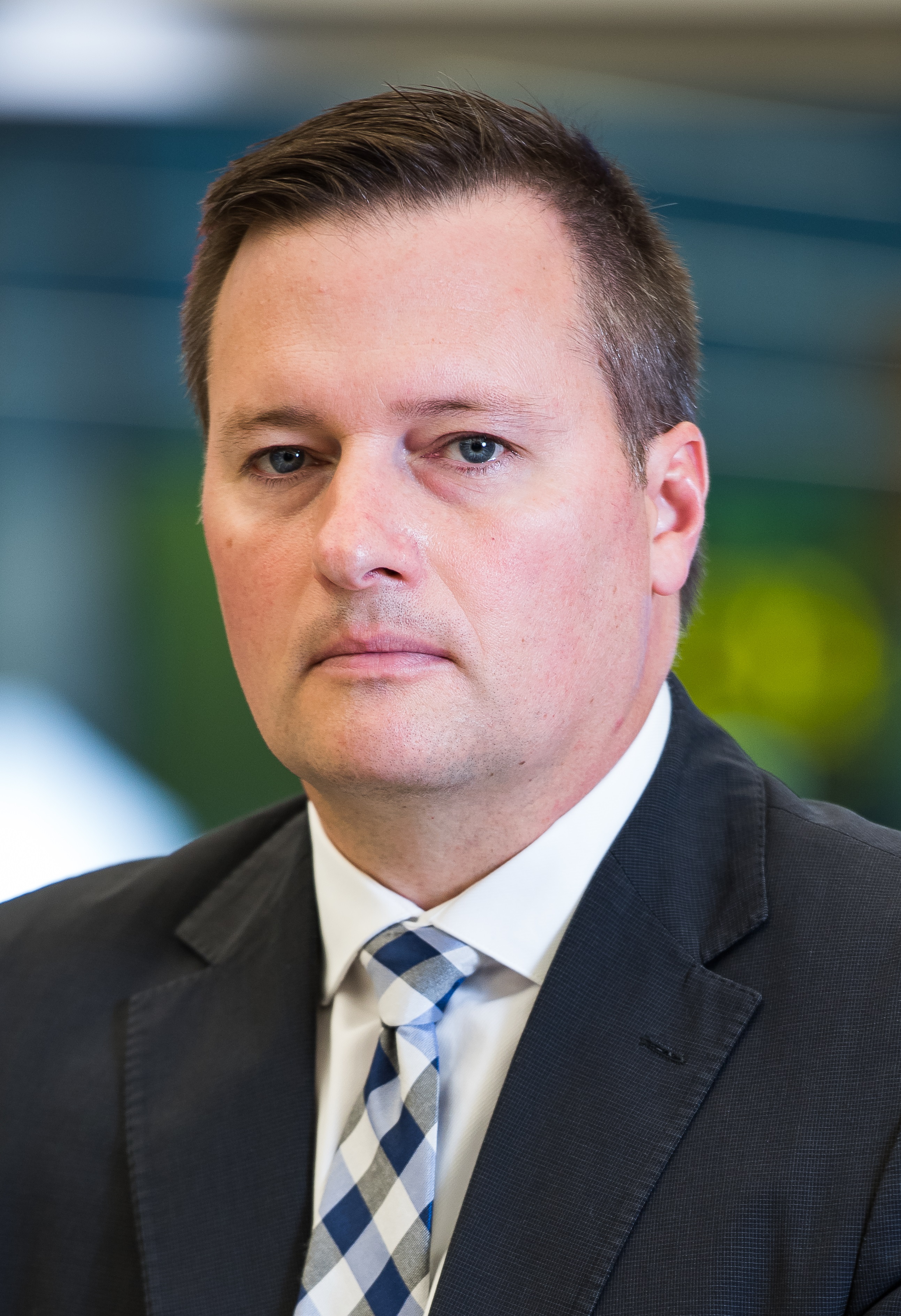
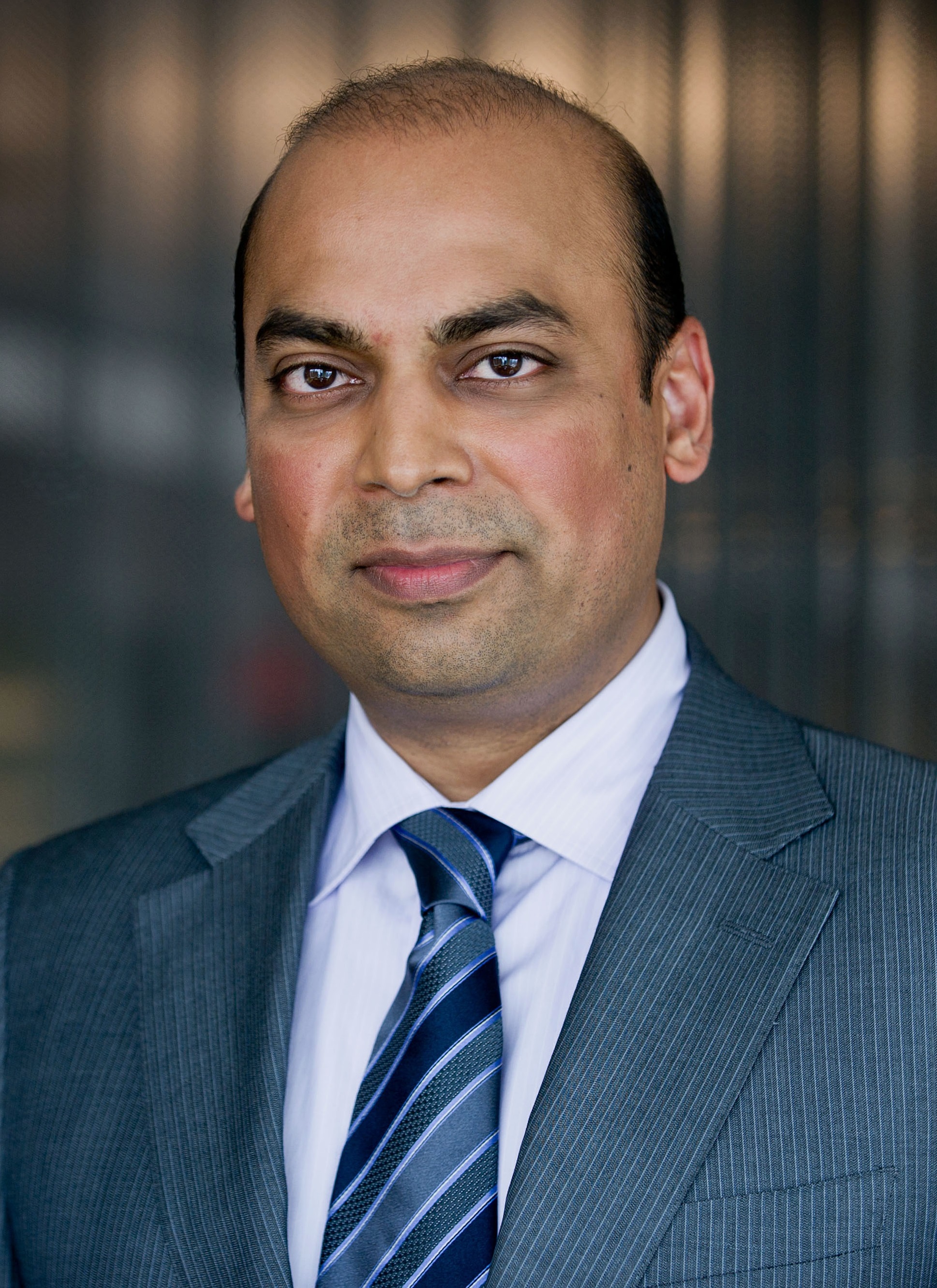
When BMO Financial Group launched its ETF business in 2009, it was a completely new direction for the bank: a new team, new focus and, importantly, a new product line as BMO Global Asset Management became the first bank affiliate in Canada to offer its own lineup of ETFs.
Rob Bechard and Kevin Gopaul have been with BMO ETFs since the very beginning. Both men have been instrumental in pushing the business forward and ensuring it continues to hit key milestones. From reaching $1 billion in assets under management only 15 months after entering the ETF market to being the top asset gatherer for seven years in a row, it’s been an exhilarating ride. However, for Gopaul and Bechard, this is just beginning.
“We started this business at zero, in a very humble position, and every dollar we brought in and every client we met was so important,” Bechard says. “That was an important starting position for us, and we have managed to keep that philosophy. All of our teams hit the ground running from day one and have maintained that momentum ever since.”
Innovation has been at the heart of BMO ETFs’ growth story. In the early days, the ETF team had the feel and flexibility of a startup, and Bechard and Gopaul were eager to encourage (and drive) an innovative and creative approach – one that remains at the core of BMO ETFs’ strategy for delivering cutting-edge solutions to Canadian investors.
“We are creative individuals by nature, and we were both institutional portfolio managers previously, so we know how to bring quality and rigour to new solutions,” Gopaul says. “Launching top-quality ETFs has created a level of confidence that has been the catalyst for more ideas to come forward, like the covered call strategy.”
Although BMO ETFs no longer flies under the radar like it did in its early days, the company is still committed to doing things differently, to making unique ideas a reality for investors. Some of the first fixed-income ETFs, synthetic ETFs and currency-hedged ETFs were managed by members of the team
“In the early days, we were taking risks to fill gaps in client portfolios that other providers were ignoring,” Bechard says. “As a result, we have grown a lot quicker than people expected. Those successes gave us the energy and confidence to really push the business aggressively forward."
Bechard and Gopaul are clearly proud of the team spirit they have created. The pair has now worked together for 15 years, and in addition to each understanding how the other operates, they recognize the importance of having a strong and happy group."
“We have voluntary turnover rate of zero, and that has helped us build an investment management team that is one of the most experienced in Canada, if not the world,” Gopaul says. “We have fostered a very collaborative and trusting culture, which makes me very proud.”
ALFRED LEE
Director, investment strategist and portfolio manager
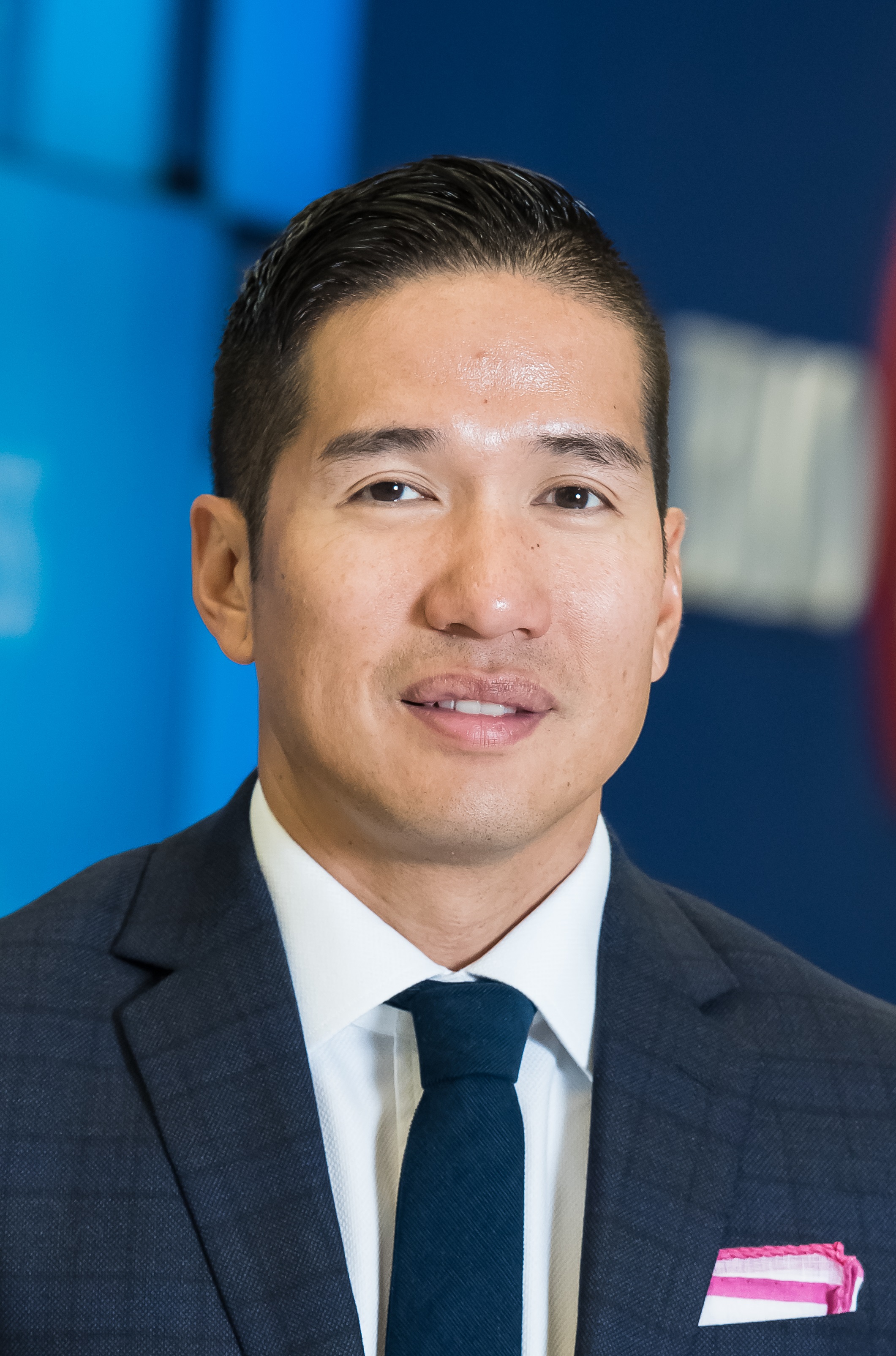
Alfred Lee was developing ETF-related strategies for a large Canada-based brokerage when he received a job offer from BMO ETFs in 2010. It didn’t take Lee very long to decide to join the BMO ETFs team – and he definitely has no regrets.
“This is by far the most enjoyable job I have had in my career,” Lee says. “A lot of the team’s core members have been here since the beginning, and there is a real entrepreneurial spirit in the group. We have built the business from zero, and we retain a lot of the characteristics and qualities that enabled us to do that.”
In addition to being an investment strategist, Lee also manages fixed-income and preferred-share mandates for both institutional and retail clients. “It is a very innovative team; we collaborate with our product team in coming up with new ideas and then help see those through to fruition,” he says. “Then, when it is trading on the exchange, we continually service the product and manage and support it from an investment perspective.”
As part of the global fixed-income ETF management team, Lee is involved in the management and trading of a wide variety of portfolios. “Compared to a traditional portfolio manager, our skill set tends to be broader,” he says. “Rather than focusing on one asset class, we are required to be experts from everything from Canadian to US bonds, emerging market bonds, preferred shares, credit derivatives and everything in between.
“We are all very hands-on with every part of the business,” Lee adds. “Although on paper, I am a portfolio manager, I am also involved with investment strategy, sales positioning, index and product design, and education for our clients and sales staff. It is a very dynamic culture we have on our team – there’s a lot of interaction with different market participants, but our main objective is that we want to make a difference for the end investor."
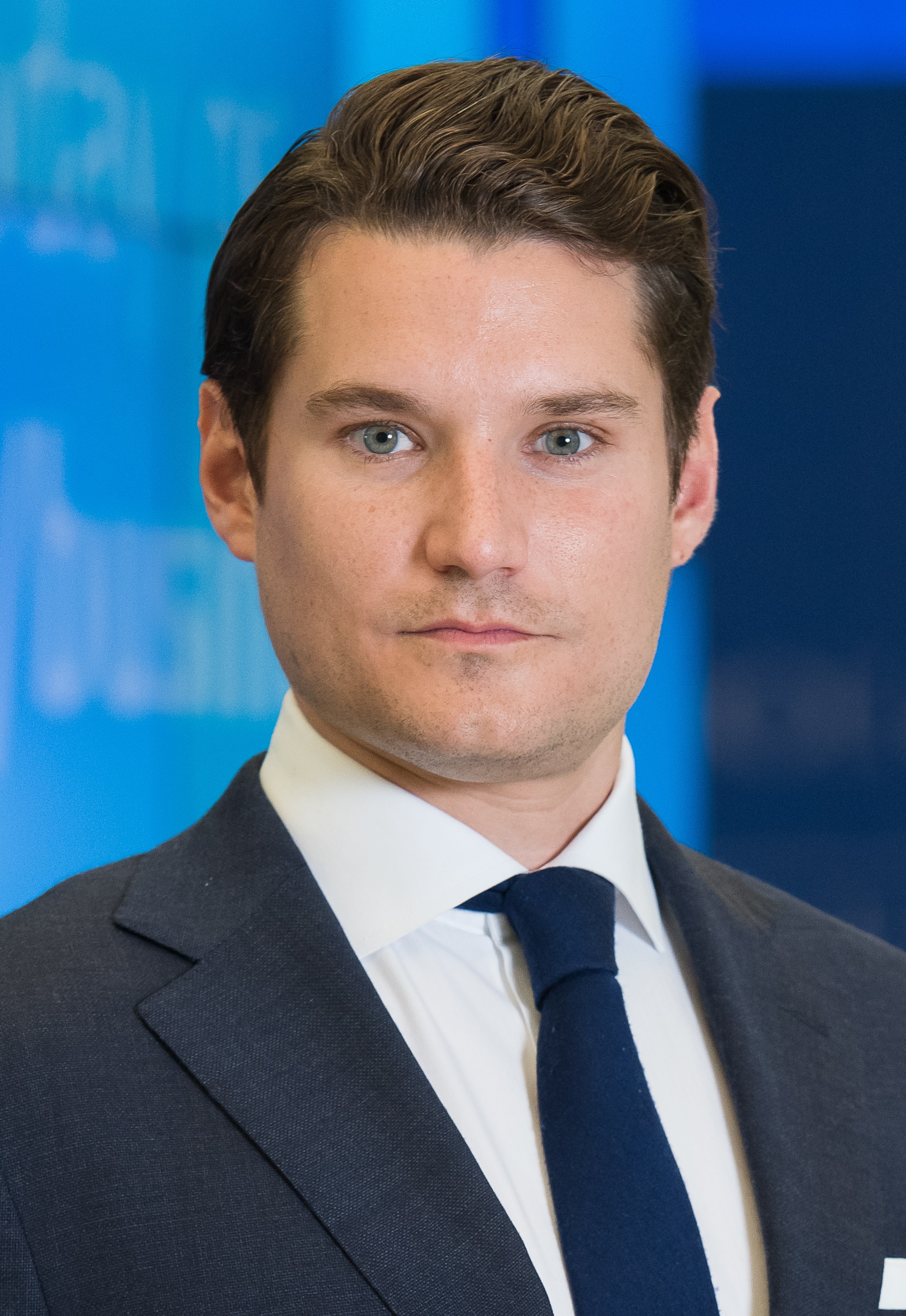
MATT MONTEMURRO
Director, portfolio manager
Matt Montemurro has been with BMO for his entire career, joining the company after graduating with an honours business administration degree from the Richard Ivey School of Business in 2009. He started on the wealth management associate rotation program, bouncing between business units and learning the different roles within wealth management. After the program, Montemurro joined BMO GAM as a trader on the active fixed-income team. He thrived in the unique and very human world of fixed-income investing.
“It is more of a relationship business compared to equity markets,” Montemurro says. “I found that my personality and skill set fit that well. Bonds are not exchange-traded, so there is still that negotiation aspect, and to succeed you need to be able to make meaningful human connections.”
It was around the same time that the ETF team was beginning to flourish. Montemurro was hearing positive things and had gotten to know Rob Bechard, Kevin Gopaul and the team, so when an opportunity arose to come onboard, he was excited at the prospect.
Montemurro joined the team in 2011 and has been an important cog ever since. He’s now a director and portfolio manager responsible for managing and trading on behalf of all ETF and passive institutional fixed income portfolios, as well as assisting with currency hedging for the BMO ETFs team.
“The team dynamic is so unique and special,” he says. “There is a pride within the team; we want to make sure we are providing the best solutions for investors. Whether that is from a sales, investment strategy or portfolio construction perspective, there is a really unique desire to ensure we are providing the best client experience.”
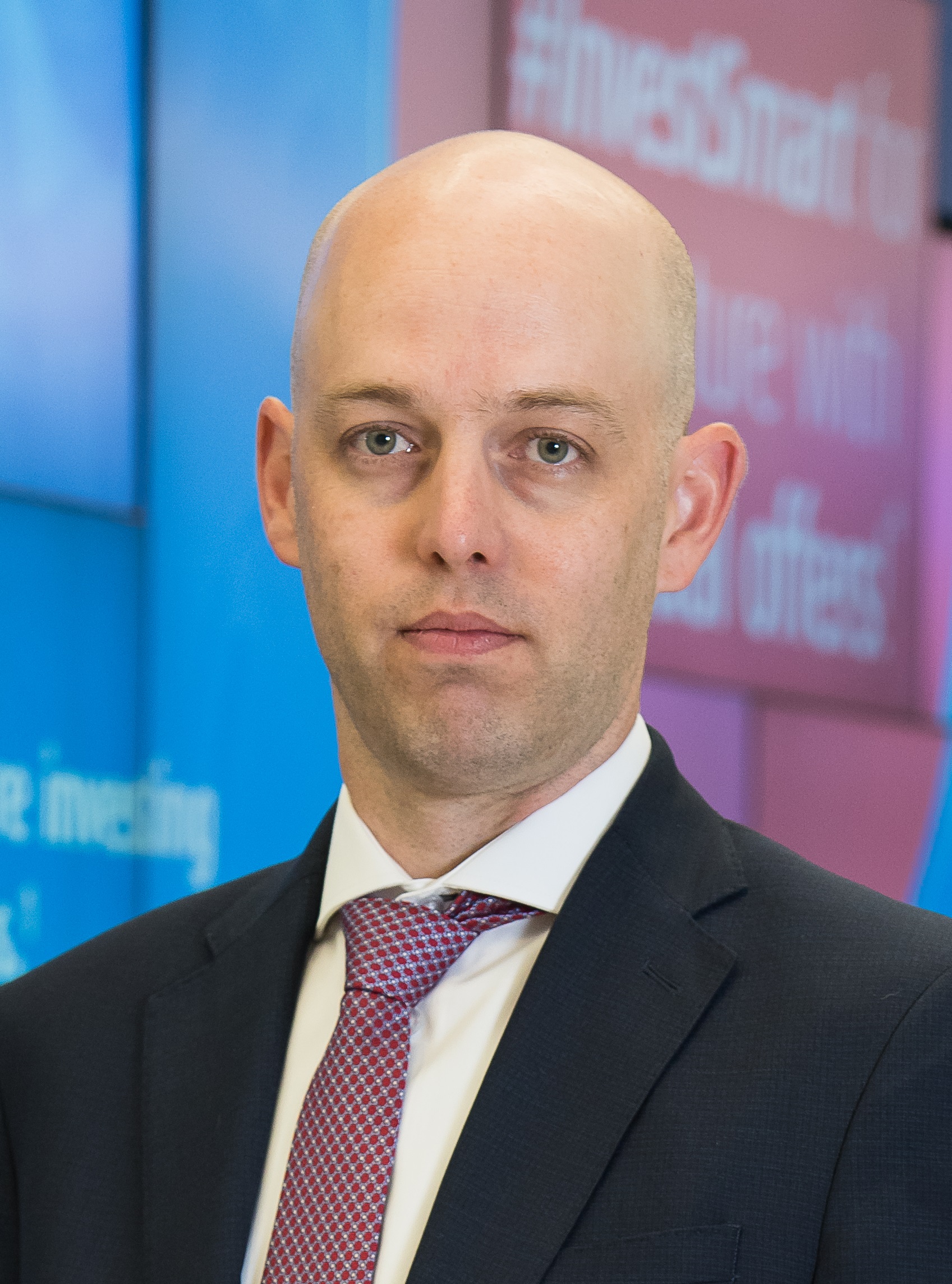
CHRIS MCHANEY
Director, portfolio manager
Chris McHaney has been with BMO ETFs since 2009 and operates as a portfolio manager for equity-based and derivativebased mandates, encompassing Canadian, US, international and emerging market equities, as well as North American and European derivatives. McHaney co-manages various cross-asset portfolios, and he also trades foreign exchange contracts and equity options for mandates across the firm.
“I focus primarily on our non-indexed, quasi-active mandates,” McHaney says. “In my previous role at BMO, I was responsible for mutual fund manager monitoring and selection, so I have a lot of experience with different investment styles on the active management side of things. Active ETFs have grown rapidly over the past few years, so that is where I have applied most of my experience.”
McHaney believes the Canadian active ETF space is well positioned for further growth, due to the fact that ETFs are regulated the same as mutual funds. “There is certainly room for more participants and further growth,” he says, “but the key is knowing which mandates will work well in the ETF format compared to a mutual fund.”
As geopolitical unrest and trade wars bring a new level of uncertainty to global markets, McHaney believes sticking to highquality, blue-chip companies is the best bet for investors. “I think those investments will perform best over the next 10 years or so,” he says, “although I do not expect them to do as well as they have in the past decade.”
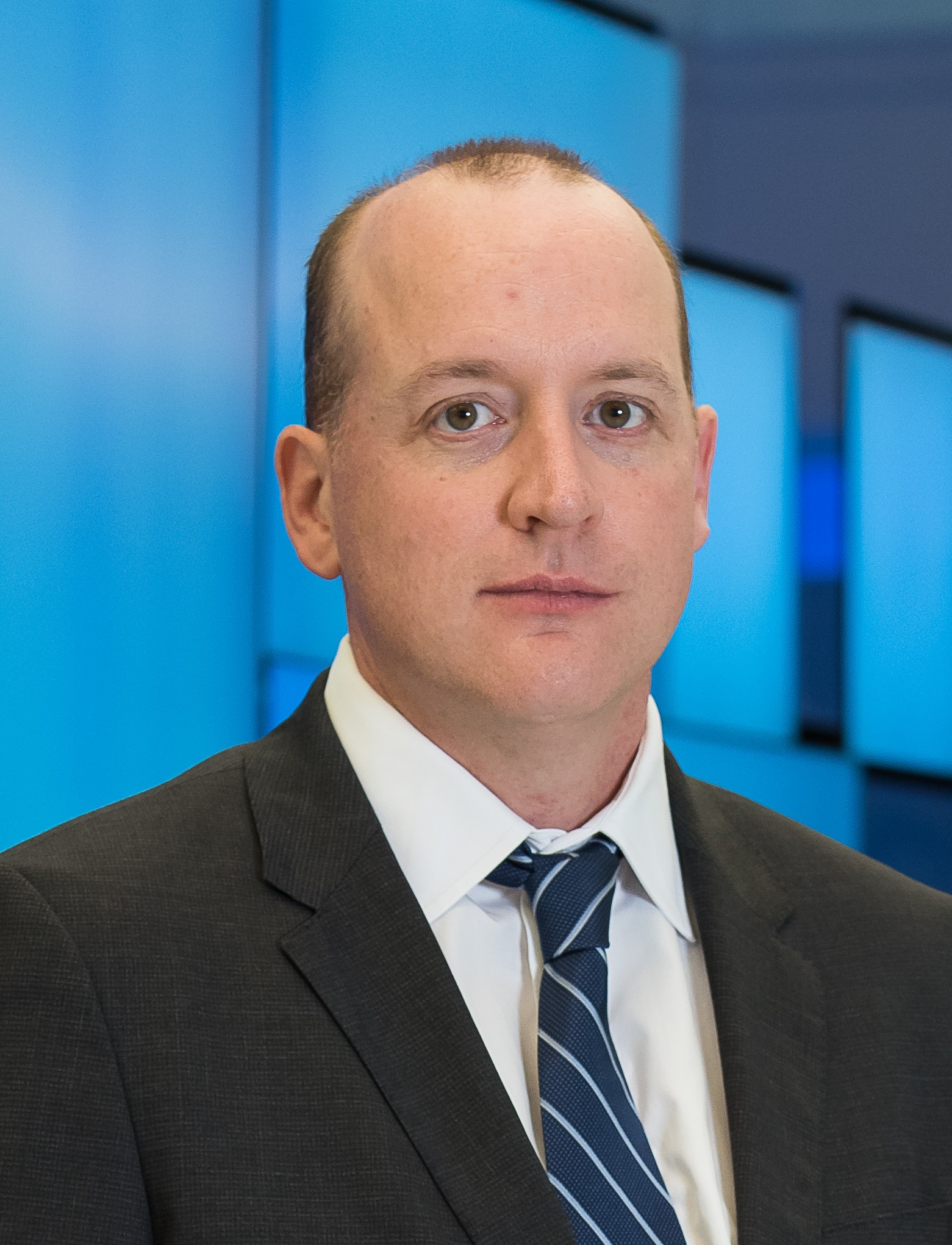
CHRIS HEAKES
Director, portfolio manager
Chris Heakes is another member of the team who has been with BMO ETFs since the very early days. He joined the BMO group in 2008 after getting a master’s of finance from the University of Toronto and moved over to BMO GAM in 2010. Heakes is a portfolio manager of equity, derivatives-based and multi-asset portfolios, and he also trades equity options and foreign exchange. He started on the quantitative equities side in 2010 and shifted to focus on ETFs in 2011.
“I have a very varied role and get to do many different types of work,” Heakes says. “On any given day, I could be looking at Canadian equities, emerging markets, EAFE, derivatives strategies or FX.”
Heakes highlights the growth of the Low Volatility Canadian Equity ETF (ZLB) as one of his proudest career achievements. He played a key role in formulating the methodology of the fund and has seen it become a real success story with AUM of more than $1.5 billion.
“It was an ETF that really grew on the fruits of its own success,” Heakes says. “It didn’t take off immediately, but slowly and surely investors have gravitated towards it. It has been really rewarding to see ZLB become one of top-ranked ETFs for Canadian equity exposures.
TREND WATCH
FACTOR BASED ETFs

As Canada's third largest ETF provider in terms of assets under management, Vanguard Canada has consistently found new ways to offer both active funds and one-ticket solutions. “We believe it has never been passive or active – it has been both,” says Tim Huver, Vanguard’s head of product. “We believe that active and passive solutions can form a meaningful part of a portfolio.”
In June 2016, Vanguard launched four factor-based ETFs, which are actively managed by its quantitative equities group: the Global Minimum Volatility ETF (VVO), which seeks to provide better risk-adjusted returns and protect against risks in equities; the Global Value Factor ETF (VVL), which attempts to outperform the market by buying into underpriced securities; the Global Momentum Factor ETF (VMO), which invests in companies that are showing momentum; and the Global Liquidity Factor ETF (VLQ), which invests in less liquid names that have a record of outperformance.
“If you look at the Minimum Volatility ETF, that is looking to provide better risk returns, while the other three are looking to outperform the market based on the performance of the single factors historically,” Huver says.
While the packaging of such factor-based ETFs is relatively new, the academic research on the concept is extensive. Constructed around a set of rules, factor-based ETFs can be used in a number of ways – they can be implemented into a portfolio that has a growth overweight or used as a lowercost satellite.
“If you look at value, momentum and liquidity, there are three underlying attributes we use to come up with the universe itself: book-to-price ratio, forward-earningsto-price ratio and cash-flow-to-price ratio,” Huver explains. “Since they are actively managed, we look at them every day and rank the factors based on the underlying attributes."
Active strategies currently occupy close to 20% of the marketplace, and Huver believes this is an area that will continue to grow.
Vanguard is looking to carve out a niche in the space by creating low-cost options to rival higher-priced active funds. Still, Huver recognizes that the appeal of factor-based products is different for each investor.
“I would say with active funds, there are three criteria for outperforming: a skilled manager, low cost and patience,” he says. “For investors who are willing to handle the volatility with active management, the factor products would be appropriate.”
Launched earlier this year, Vanguard’s asset allocation ETFs – the Balanced ETF Portfolio (VBAL), Conservative ETF Portfolio (VCNS) and Growth ETF Portfolio (VGRO) – are another innovation. One of the fastestgrowing products in the industry, this ‘ETFs of ETFs’ strategy gives investors access to more than 25,000 individual equities and fixed- income bonds. These low-cost asset allocation ETFs are passively managed and rebalanced within the fund.
“They can be the core of a portfolio or a core satellite where you have active satellites around the core portfolio,” Huver says. “For an advisor, it can be a scalable solution for a number of broad clients.”
Constructed entirely from Vanguard’s passively managed ETFs, the asset allocation ETFs aim to provide exposure to the entire market to give investors a one-ticket solution – meaning they could serve as an entire portfolio, Huver says, although he recommends incorporating both active and passive strategies to form the core and satellite of a portfolio. It is this combination that both Huver and Vanguard believe will continue to be vital to all investors’ portfolios.
LOWER FEES
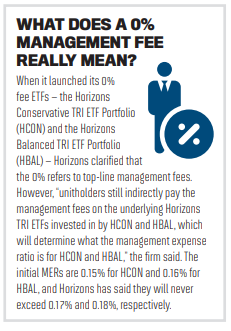
Mark Noble, Horizons’ SVP and head of sales strategy, says the firm’s entry into both thematic ETFs and low-cost products was designed to help it compete in a market crowded with bigger players.
“There has been a lot of coverage in the Canadian ETF space of the major asset classes,” Noble says. “Everyone is trying to capture the next big idea. When you look at the wellestablished asset classes, it is pretty crowded by providers, and that’s why you’re starting to see the race to 0% management fees. You need to look for new ideas and new products.”
One of the best examples is Horizons’ marijuana ETF, launched in April 2017, which has become somewhat of the benchmark for the sector. “The marijuana ETF is one of the fastest growing in Canada and now has over $1 billion in AUM,” Noble says. “At first there needed to be more stocks for diversification and liquidity for the ETF to trade; by April of 2017, there were. The second challenge was regulation – there were more regulations that needed to be signed off on, but once it launched, it became the same as any other ETF offering a one-ticket solution.”
Horizons’ marijuana ETF has succeeded in attracting people to the sector. Noble reports that it has been embraced by direct clients buying through a discount brokerage, which reinforces the notion that it has offered access to even more investors.
While Noble can’t say for sure what’s in store for the ETF, he does note that a lot of it depends on industry news. Even after the October 17 legalization, he believes the ETF could be in for more growth as large companies consolidate and invest in producers; he points to Constellation Brands’ recent move to invest in Canopy Growth as an example. “Large companies buying in provide a premium, so we may get a better idea 18 months from now,” he says.
Another area where Horizons has taken the lead in the ETF space is offering funds with 0% management fees – it introduced two passive ETF portfolios in early August with no top-line management fees. For Noble, this was a straightforward decision, as reducing costs is a big selling point.
“The products are a total return from a synthetic structure, meaning they don’t own bonds and allow for different taxation unless sold,” he explains. “There are still underlying fees on performance, but the 0% management fees drive down the overall cost. All-in, they are still 25 basis points.”
These portfolios, he says, help to empower investors by eliminating any worries about added fees. “The benefit, in terms of indexing, is that cost is the biggest hurdle for investors. Having the option for a lower cost and higher return eliminates that.”
This race to the bottom of the fee tier could be the next evolution of the industry. Noble believes Canada could see more ETFs with 0% management fees, minus taxes, in the coming years.
“If a low-cost option’s performance is on par, advisors will be forced to rationalize their decisions as to why they are choosing higherpriced options. Sometimes they are justified if they want access to something specific. Ultimately, with many advisors moving to a fee-based model, advisors can reduce costs for clients and focus on other things like asset allocation and goals for money. In the big picture, reducing cost for their clients is a win-win.”
FIXED-INCOME ETFs
Bond investments have been under considerable pressure lately. With interest rates on the rise, things are changing within the bond landscape. However, RBC Global Asset Management has evolved its bond products to offer fixed-income investors the opportunity for better rates of return than GICs – effectively giving investors a better return stream in addition to greater liquidity.
RBC GAM has been offering ETFs since 2011; until 2014, the firm only offered fixedincome products. It launched its ETF suite with the Target Maturity Corporate Bond (TMCB) ETFs and moved into laddered bond products. While RBC GAM does now offer actively managed solutions, the TMCB series remains the core. Trevor Cummings, head of business development for ETFs at RBC GAM, believes these types of products can help investors and advisors whose strengths are on the equity side of the market.
“In my experience, most investment professionals’ forte lies on the equity side of the portfolio,” Cummings says. “If they need fixed-income products for an investor, spending time on fixed income can mean spending less time managing equities, financial planning or gathering assets, and it becomes an expensive proposition from a time perspective.”
RBC’s TMCB ETFs are index products that follow FTSE Canadian Bond Indices. “What we do as the provider is follow suit and mimic the index the same way a competitor might follow the S&P 500 Index or the TSX Composite Index,” Cummings says. “How those indices work is they target specific bonds – a collection of bonds that mature in a given calendar year, screened for issue size, liquidity, tradeability and credit quality."
The prices of the TMCB ETFs are close to par, and in some instances even trade below par value, for the bond portfolio. “Unlike buying bonds or bond ETFs several years ago, where you were looking to get your coupon but your price would go down, there are more options today,” Cummings says. “You can buy a bond ETF, get your coupon while you invest in that ETF, and if you hold it to maturity, there are some capital gains that are likely in the portfolio.”
The success of the TMCB suite led RBC to introduce Laddered Corporate Bond ETFs when they noticed investors were essentially building their own ladders with TMCB components. “It is sort of a labour savings, as there is no additional fee to purchase the ladder versus components,” Cummings says. “It makes it easier for investors because they can set it and forget it.”
The advantage to both the TMCB suite and Laddered Corporate Bond ETFs is that they are specific and targeted. “Because the TMCB ETFs follow specific indices, you know exactly what you are going to get and what you are not because we are following the rules of that index in managing the ETF,” Cummings says. “The ladder takes labour, cost or effort savings one step further.”
Cummings says these products may not be the end-all solutions for all investors. That’s why RBC GAM also has active fixed-income solutions like the US Corporate Bond strategy and the Diversified Global Monthly Income ETF. However, for investors and advisors looking to add fixed-income solutions to their portfolios, the TMCB and Laddered Corporate Bond ETFs can make the process easier and less time-consuming.
AN ALTERNATIVE EXCHANGE
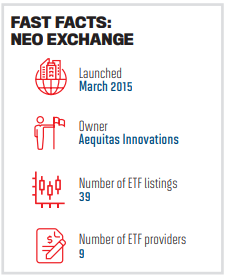
“Exchange diversification is an important element of Invesco’s ETF listing strategy,” explains Christopher Doll, vice-president of ETF sales and strategy at Invesco. “Adding exchange partners encourages continuous innovation and fosters stronger competition within Canadian capital markets. This should lead to a better experience for clients.”
The NEO Exchange uses a blueprint that prioritizes investors, dealers and businesses looking to raise capital. It offers an innovative trading venue and a value-added listing venue for companies and investment products. As a firm that has always prized innovation and strategy, Invesco felt that creating a partnership with the NEO was a no-brainer.
“Invesco has always been at the forefront of innovation,” Doll says. “It’s in our DNA, and the partnership we have cultivated with NEO from the very beginning has been part of our overall philosophy.”
Since its first listing, Invesco has expanded to four ETFs on the NEO, including the Invesco 1-10 Year Laddered Investment Grade Corporate Bond Index ETF (PIB), the Invesco S&P Global ex Canada High Dividend Low Volatility Index ETF (GHD) and the Invesco Long-Term Government Bond Index ETF (PGL). While Invesco was the first, the NEO now boast several ETF providers and numerous products.
“What’s really been impressive is the mass adoption of NEO as a viable listing venue by other ETF providers,” Doll says. “There are now 59 tickers across 39 products from nine different ETF providers listed on the NEO Exchange.”
Doll notes that Invesco still has multiple products listed on the TSX, but he believes listing on the NEO will only improve quality in the industry. “Competition in any industry helps foster innovation, better customer service and cost reduction – all things that factored into our initial decision-making process,” he says.
While an alternative exchange is a great option for providers as they look to distinguish themselves from bigger firms, Doll points out that where an ETF is listed shouldn’t factor into whether an advisor includes that fund in their portfolio. “The primary drivers for selecting ETFs include investment exposure, investment strategy and objectives, liquidity, and cost,” he says.
STRATEGIC BETA ETFs
Strategic beta is one of the fastest-growing segments of the ETF industry. Boasting a combination of traditional indexing and active management, strategic beta ETFs are becoming more popular as core investments that can prove to be dynamic and lucrative to investors.
Michael Cooke, senior vice-president of ETFs at Mackenzie Investments, highlights how the firm’s strategic beta ETFs are using technology that analyzes risk exposure and ensures a diversified ETF. “The solutions are index-based and are governed by a clear and transparent set of rules that inform the construction of the portfolios,” Cooke says. “Strategic beta is effectively blending together traditional capitalization of indexing and active management.”
Mackenzie first launched its ETF suite in April 2016 and now offers 28 different ETFs, which account for $2.8 billion in assets under management. That includes six strategic beta ETFs that range from emerging markets to developed Europe to US equity indices. To offer strategic beta ETFs, Mackenzie has partnered with TOBAM, which is responsible for the intellectual property behind Mackenzie’s Maximum Diversification Index Series.
The ETFs are built by analyzing volatility at the single-stock level. Risk factors that drive performance are determined, and then exposure to certain industries is adjusted.
“If we look at the Canadian market, specifically the abundance of companies in financial services or resource sectors, the risk factors that drive the performance are fairly narrow,” Cooke says. “As such, we are overexposed to a small subset of risk factors that dive the returns of the Canadian stock market. If we could find a more equitable blend of representation across a broad array of risk factors, we still have exposure to financials and resource companies, but we have diversified away from an overconcentration to those risk factors.”
Mackenzie’s strategic beta ETFs cover an entire spectrum of equity markets, meaning investors get a broad range of exposure to a particular market and are earning the full premium to assume that risk. “Where we differentiate is allocation to all known and unknown risk factors,” Cooke says. “Sometimes a portfolio is prone to too much exposure in a very narrow set of risk factors. What might appear on the surface to be a diversified portfolio is not if you look at the risk factors that impact the return profile of that market.
The strategy in the Maximum Diversification Series encompasses a broad array of exposures. “They are not single-factor strategic beta products,” Cooke says. “They are core strategies that blend together different elements to arrive at this patented rulesdriven approach that has delivered better risk to returns over time.”
One ETF in the series that is particularly interesting is the Mackenzie Maximum Diversification Emerging Markets Index (MEE). Cooke notes that it’s important to distinguish between the short and long term with these types of investments. “Despite more inherent risk, on the basis of geopolitics or the emerging nature of economies, you are subject to more volatility in the short term,” he says. “Long term, these growth characteristics show that you will be rewarded with returns in an equity portfolio.”
Cooke outlines that the more inefficient the market, the more possibility a strategic beta portfolio has to generate alpha. That maximum diversification approach can smooth out volatility and help investors stay engaged in allocating toward emerging market equity.
For advisors looking for an appropriate blend of risk management, fee budgeting, liquidity, transparency, access to a particular market and a solution that can manage risk in a cost-effective fashion, strategic beta solutions are becoming an enticing core option for portfolios.
THEMATIC ETFs
The investor landscape is changing: Huge amounts of money are about to transfer from baby boomers to millennials. This new generation of investors has different priorities than those who preceded them. For millennials, it’s important to invest in sectors and companies that mean something to them – and that has made certain underserved sectors a new frontier for ETF providers.
Industry veteran Raj Lala says that was his motivation when he founded Evolve ETFs in 2017. “I asked myself if there was room for another issuer,” he says. “I thought if I put together a creative product and a good strategy, there would be room to compete.”
That’s just what he did, targeting underserved sectors with thematic ETFs, which are designed to prioritize specific themes or issues in a portfolio. Evolve’s four base thematic ETFs are the Evolve Cyber Security Index ETF (CYBR), the Evolve North American Gender Diversity Index ETF (HERS), the Evolve Automobile Innovation Index ETF (CARS) and the Evolve Innovation Index ETF (EDGE). “Through these ETFs, advisors and clients can have a specific view on an area of the market and enhance the overall potential for alpha in their portfolio,” Lala says.
Evolve has been the first provider in Canada to target cybersecurity, gender diversity and innovation, and the first globally to target the auto industry. “When you look at cybersecurity and gender diversity, we have noticed an increase in the demand,” Lala explains. “They are areas in which we don’t see the trends reversing.
“When it comes to CARS,” he continues, “we see self-driving and electrification as a big part of the future. It’s not a matter of technology but rather legislation. When you consider the demographics of the investors who are about to inherit the world’s wealth, they want their investments to have an impact in those areas.”
Lala notes that when it comes to thematic ETFs, it’s important for advisors and investors to take a long-term approach, which is something his firm does when constructing the products by focusing on where the global market is going and not on fads.
All four of Evolve’s thematic ETFs are passive index-based products. For CYBR, EDGE and CARS, Solactive AG provides the index, while a FactSet classification system determines which companies fall into the category. “We use this classification service to determine if a company is involved in cybersecurity,” Lala explains. “If they are part of that FactSet universe – in the case of cybersecurity, there are about 30 positions – they make up the CYBR ETF.”
In the case of HERS, Evolve is a little more involved. Solactive is still the index provider, but Evolve has partnered with Equileap to create the methodology to determine which companies are most proactive with gender diversity.
For Lala, the biggest advantage of investing in thematic ETFs is that it can allow investors an opportunity to practice values-based investing without sacrificing diversification.
“You can express a certain view in an area of the market without having to pick single companies,” he says. “The ETF provides a one-stop proxy on that specific theme. A great example would be CARS and the recent example of Tesla. Six months ago, if we talked to someone about the future of the car industry, many might say they don’t need a CARS ETF because they’re going to buy Tesla. Obviously that may not have been such a good idea, and that’s why you want to take a diversified approach to a theme.”
STANDING OUT IN THE MARKET
As the ETF industry continues to grow at a rapid pace, it’s becoming more and more challenging for smaller firms to get in. It’s no longer enough to show advisors and investors why an ETF is slightly better – there needs to be something that differentiates the product, or else it will struggle to gain traction in the marketplace.
One person who knows this scenario all too well is Som Seif, the president and CEO of Purpose Investments, who has launched two successful ETF companies. After selling his previous firm, Claymore Investments, to BlackRock, Seif was inspired to start Purpose after noticing a void in the market for products that could manage risk, help clients with outcomes, and help advisors build better portfolios and target specific areas.
“I built it on the principles of how do you pick the best of what active money management does and passive indexing and put it together?” Seif says. The strategy clearly worked: Today, Purpose has nearly $6 billion in assets.
One of the things that makes Purpose unique is its fund offerings – the firm doesn’t look at a fund as being just an ETF or a mutual fund, but rather considers its ability to be both. Purpose currently offers more than 50 funds across numerous asset classes, 30 of which have an ETF option – something that was unique in Canada when Purpose started offering it.
“ETFs are just mutual funds that trade,” Seif says, “and our opinion is that when someone is investing, they are looking for the best strategy in the most efficient format for them. ETFs are one vehicle, but other types of investors think mutual funds are better.”
Purpose has introduced numerous other innovations, including real assets, hedged equity, and long and short equity strategies. “All of these things are very unique to us, as we are the first firm in Canada to do these things and offer a transparent and public prospectus forum available for all investors,” Seif says.
One area Purpose has specialized in is structured pension funds. “We built a suite of resilient pension-style portfolios,” Seif says. “Some are based on allocation decisions, and some follow a quantitative process, but all are designed to give investors more stable ways to get returns like a pension plan would. They hold traditional asset classes like equity and fixed income, along with alternative assets and other income strategies, all designed to drive down risk and manage a more steady return.”
Purpose has four of these products, which are designed as an alternative to a conservative investment strategy. Seif explains that traditional conservative strategies tend to focus too much on bond exposure, a risky part of the market today. His strategies use more of a risk management approach to generate similar returns to bonds without the same interest rate exposure.
When applying such unique strategies, Seif says Purpose’s goal is to focus on the outcome and base strategies on what they hope to accomplish from a risk/reward perspective. That includes taking advantage of market exposure on a risk management basis or implementing an alternative strategy.
Seif believes smaller firms need this type of innovation to differentiate themselves and stay relevant. “Adding value beyond just adding market benchmarks and indexes – that’s where smart innovation can help you differentiate yourself,” he says. “When you are able to bring real value-added innovation through thought leadership, I think investors win in the end, and that is the most important thing.”

